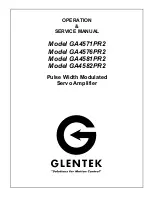
GLENTEK Inc. 208 Standard Street, El Segundo, California 90245, U.S.A. (310) 322-3026
9
2.2.2 VELOCITY - MODE OR CURRENT- MODE OPTIONS:
The
GA45xxPR2 is most often used to close a critically-damped velocity-loop using a DC tachome-
ter for velocity feedback. However, this high-gain, summing amplifier can be bypassed to provide an
input directly to the current-loop amplifier (Refer to Appendix C, drawings 4597-7010 & 4597-7012). If
the amplifier is ordered with a Current Mode option, the dedicated Current Mode Personality Preamp
Card will be used. (Refer to Appendix C, drawings 4597-5110 & 4597-5112)
2.2.3 LOGIC-INPUT CONFIGURATION:
There are four logic inputs:
±
Limits, Inhibit, and Reset. They may be configured for active-high or
active-low signals, and pulled-up or pulled-down termination (type A, B, C, and D). In addition, the four
inputs may be configured to operate over a 0 to
+5VDC or 0 to +15VDC range.
Type A: Requires grounding of input to disable amplifier.
Type B: Requires a positive voltage at input to disable amplifier.
Type C: Requires grounding of input to enable amplifier.
Type D: Requires a positive voltage at input to enable amplifier.
The amplifier is normally shipped with type ‘A’ input configuration and 0 to +15VDC input range.
2.3 PROTECTION CIRCUITS:
The following protection circuits are integral to the GA45xxPR2 plifier to prevent damage to the amplifier or
your equipment. Again, Glentek is anxious to work with you in helping to implement any circuit functions your
system might require. Note: For sections 2.3.1 to 2.3.7, refer to Appendix B, drawing 4581-4010.
2.3.1 OVER-TEMP INDICATOR OPERATION (RED LED):
The Over-Temp LED indicator light (D29) will turn ON and latch when the heatsink temperature
exceeds 170
0
F (77
0
C).
2.3.2 DRIVE INHIBIT INDICATOR (RED LED) AND FAULT RELAY OPERATION:
The Drive Inhibit LED indicator light (D30) will turn ON and the Fault relay (K1) will energize for any of
the following fault conditions, the first four of which are latched:
1. Transistor heatsink temperature in excess of 170
0
F (77
0
C)
2. Tach-loss fault circuit triggered.
CHAPTER TWO: DESCRIPTION, MODEL NUMBERING, AND SPECIFICATIONS










































